Analysis of Flow Characteristics at the Inlet of a Circular Involute Variable Wall Thickness Scroll Expander
Abstract
:1. Introduction
2. Geometric Model
2.1. Establishing the Circular Involute Variable Wall Thickness Scroll Profile
- , are natural numbers and ;
- ;
- and .
2.2. Inlet Shape Design
- (1)
- At any given moment, the air inlet should be connected to the suction cavity in order to avoid vibrations and uneven forces in the expansion process.
- (2)
- The largest intake area should be obtained to minimize the tooth head intrusion rates to reduce high-energy state gas power losses at the intake.
- (3)
- The air inlet should not have sharp corners. Air intakes with sharp corners would lead to increased local resistance and airflow friction during air intake, thus increasing mechanical losses.
2.3. Performance Evaluation Criteria for Scroll Expanders
3. CFD Numerical Simulation
3.1. Mesh Division and Mesh Independence Verification
3.2. Dynamic Mesh Technique and Key Parameter Setting
3.3. CFD Numerical Simulation Verification
4. Data Analysis
4.1. Flow Field Changes
4.1.1. Working Cavity Pressure Field
4.1.2. Working Cavity Velocity Field
4.1.3. Suction Tube Velocity Field
4.2. Output Characteristics
4.2.1. Tooth Head Invasion Rate and Inlet Flow Rate
4.2.2. Gas Force and Driving Torque Analysis
4.2.3. Expander Performance Analysis
5. Conclusions
- (1)
- When the air inlet was fully open, the pressure in the working cavity of the scroll expander with elliptical and double circular slotted air inlets was more evenly distributed as compared to a scroll expander with a circular air inlet. Under the joint action of the two adjacent working chambers, the pressure at the engagement clearance of the two scroll plates was low in the middle and high at both ends. Due to the use of scroll expander suction pipe of high-pressure gas in the form of a spiral flowing into the scroll expander suction cavity and the periodic blocking of the scroll teeth, an uneven distribution of the flow rate of each gas workpiece was observed, and the scroll expander working cavity demonstrated significant swirling phenomena.
- (2)
- The transient inlet flow rate, gas force, and driving torque variations of the scroll expander fluctuated significantly due to the periodic shading of the inlet by the orbiting scroll disc tooth head and the throttling effect on the inlet. The scroll expander had the largest axial gas force and the smallest radial gas force. The driving torque of the scroll expander with double circular groove and elliptical inlet increased by 16.84% and 14.29% compared to the circular inlet, but the axial and radial forces in the scroll expander also increased somewhat, and the leakage tendency in the expander increased.
- (3)
- The elliptical and double arc groove inlets increased the inlet flow rate by 19.93% and 27.73% relative to the circular inlet while ensuring a certain inlet area when the tooth head was invaded. Compared to the inlet power loss of circular scroll expanders, the inlet power loss of elliptical and double circular groove scroll expanders was reduced by 42.8% and 48.53%. As a result, it was observed that elliptical and double arc groove inlet designs are superior compared to conventional circular inlets, provided that the design requirements are maintained.
Author Contributions
Funding
Data Availability Statement
Acknowledgments
Conflicts of Interest
Abbreviations
| CFD | Computational fluid dynamics |
| ORC | Organic rankine cycle |
Nomenclature
| The actual effective area of the air inlet | |
| The airflow friction factor at the air inlet | |
| The gas density at the air inlet | |
| The flow rate at the air inlet | |
| The rotational speed of the orbiting scroll | |
| The air inlet volume | |
| The effective area of the air inlet not invaded by the tooth head | |
| Radial gas force | |
| Tangential gas force | |
| Axial gas force | |
| The turbulent energy production term due to the time-averaged velocity gradient | |
| The turbulent energy production term due to buoyancy | |
| The effect of pulsation expansion on the overall dissipation rate in compressible turbulence | |
| The inverse effective Prandtl numbers corresponding to | |
| The inverse effective Prandtl numbers corresponding to | |
| , | The custom source terms |
| The effective turbulent viscosity. |
References
- Peng, B.; Yang, B.K.; Gong, K.G.; Zhang, P.C.; Xu, J.W.; Liu, H.X. Research on thermodynamic characteristics and experimental verification of ORC oil-free scroll expander. Therm. Power Gener. 2023, 52, 60–69. [Google Scholar]
- Wang, L.; Bu, X.; Li, H. Multi-objective optimization and off-design evaluation of organic rankine cycle (ORC) for low-grade waste heat recovery. Energy 2020, 203, 117809. [Google Scholar] [CrossRef]
- Hu, S.; Yang, Z.; Li, J.; Duan, Y. A Review of Multi-Objective Optimization in Organic Rankine Cycle (ORC) System Design. Energies 2021, 14, 6492. [Google Scholar] [CrossRef]
- Olabi, A.G.; Wilberforce, T.; Ramadan, M.; Abdelkareem, M.A.; Alami, A.H. Compressed air energy storage systems: Components and operating parameters—A review. J. Energy Storage 2021, 34, 24. [Google Scholar] [CrossRef]
- Wei, J.Y.; Hua, Q.; Yuan, L.; Li, G.; Wang, J.H.; Wang, J.D. A review of the research status of scroll expander. Proc. Inst. Mech. Eng. Part A-J. Power Energy 2023, 237, 176–197. [Google Scholar] [CrossRef]
- Peng, B.; Li, Y.; Zhao, S. Performance Simulation for Scroll Expanders. China Mech. Eng. 2018, 29, 965–970+978. [Google Scholar]
- Feng, Y.Q.; Xu, J.W.; He, Z.X.; Hung, T.C.; Shao, M.; Zhang, F.Y. Numerical simulation and optimal design of scroll expander applied in a small-scale organic rankine cycle. Energy 2022, 260, 124981. [Google Scholar] [CrossRef]
- Sun, J.; Peng, B.; Zhu, B.; Li, Y. Research on the performance characteristics of an oil-free scroll expander that is applied to a micro-scale compressed air energy storage system. J. Energy Storage 2023, 63, 106896. [Google Scholar] [CrossRef]
- Peng, B.; Zhang, P.C. Mathematical modelling and experimental study of a variable cross-section scroll expander. Mach. Des. Manuf. Eng. 2018, 47, 115–120. [Google Scholar]
- Li, X.Q.; Han, Y.; Xi, Z.J.; Li, X.Y.; Wang, J.; Dong, L.N. Design and analysis of mechanical performance of asymmetric variable thickness scroll wraps for scroll compressor. Fluid Mach. 2021, 49, 35–41. [Google Scholar]
- Liu, T.; Feng, Z.G.; Sun, Y.J. Equivalent tooth thickness model and geometric performance analysis of IHV variable cross-section scroll profile. Fluid Mach. 2021, 49, 55–61. [Google Scholar]
- Hou, C.-S.; Liu, T.; Guo, L.-X. Construction theories of a new type of variable wall thickness scroll profile. J. Jilin Univ. (Eng. Technol. Ed.) 2020, 50, 1627–1634. [Google Scholar]
- Emhardt, S.; Tian, G.; Song, P.; Chew, J.; Wei, M. CFD modelling of small scale ORC scroll expanders using variable wall thicknesses. Energy 2020, 199, 117399. [Google Scholar] [CrossRef]
- Hao, H.M.; Wu, L.P.; Li, L.; Zou, X.M.; Chen, L.; Chen, X.Y.; Zou, G.Q. Study on Geometric Model of the Combined Cross–Sectional Vortex Expander. Mech. Res. Appl. 2021, 34, 66–68+72. [Google Scholar]
- Jia, J.P.; Li, Y.F.; Liu, G.P.; Zhang, G.L.; Li, B. Optimization analysis of the scroll expander specialtop profile correction in the inlet port. J. Mech. Strength 2017, 39, 657–662. [Google Scholar]
- Chu, X.G.; Zhang, C.H.; Li, K.; Kong, Y.; Jing, Y.F. Scroll expander modification and test performance study. J. Xi’an Jiaotong Univ. 2014, 48, 37–41+100. [Google Scholar]
- Wei, M.; Song, P.; Zhao, B.; Shi, L.; Wang, Z.; Ma, C. Unsteady flow in the suction process of a scroll expander for an ORC waste heat recovery system. Appl. Therm. Eng. 2015, 78, 460–470. [Google Scholar] [CrossRef]
- Song, P.P.; Wei, M.S.; Liu, Z.; Zhao, B. Effects of suction port arrangements on a scroll expander for a small scale ORC system based on CFD approach. Appl. Energy 2015, 150, 274–285. [Google Scholar] [CrossRef]
- Peng, Z.; Bin, P.; Jie, M. Geometrical modelling analysis of variable cross-section scroll expanders. J. Shanghai Jiaotong Univ. 2023, 57, 309–315. [Google Scholar]
- Zhang, P.-C.; Peng, B.; Zhang, Y.-B. Method and theory of establishing variable thickness scrolls based on circle involute. J. Jilin Univ. (Eng. Technol. Ed.) 2022, 52, 789–798. [Google Scholar]
- Peng, B.; Jiang, L. Parameter analysis and optimization of modification of tooth head of scroll profile. J. Huazhong Univ. Sci. Technol. (Nat. Sci. Ed.) 2020, 48, 107–112. [Google Scholar]
- Wu, Z.; Yan, J.; Xie, F.B.; Zhu, T.; Gao, N.P. Research on the Effect of Suction Port Shape on a Scroll Expander Pressure Loss during the Suction Process. Compress. Technol. 2016, 01, 1–6+12. [Google Scholar]
- Song, P. Numerical Investigations on Unsteady Flow of a Scroll Expander for Organic Rankine Cycle. Ph.D. Thesis, School of Mechanical Engineering, Beijing Institute of Technology, Beijng, China, 2015. [Google Scholar]
- Liu, Z.; Wei, M.; Song, P.; Emhardt, S.; Tian, G.; Huang, Z. The fluid-thermal-solid coupling analysis of a scroll expander used in an ORC waste heat recovery system. Appl. Therm. Eng. 2018, 138, 72–82. [Google Scholar] [CrossRef]
- Wu, Z.; Fang, X.Y.; Zhu, T. Effects of Radial Clearance on Performances of Scroll Expander. Mach. Des. Manuf. 2017, 9, 41–44+48. [Google Scholar]
- Liu, Z.; Wu, H.W.; Lin, X.; Song, P.P. Unsteady flows of a scroll expander under various types of expansion process. Energy Storage Sci. Technol. 2019, 8, 1241–1246. [Google Scholar]
- Liu, Z.; Wu, H.W.; Hang, J.; Kuang, Y. Numerical investigations on unsteady flow of a scroll expander forcompressed air energy storage. Energy Storage Sci. Technol. 2019, 8, 357–364. [Google Scholar]
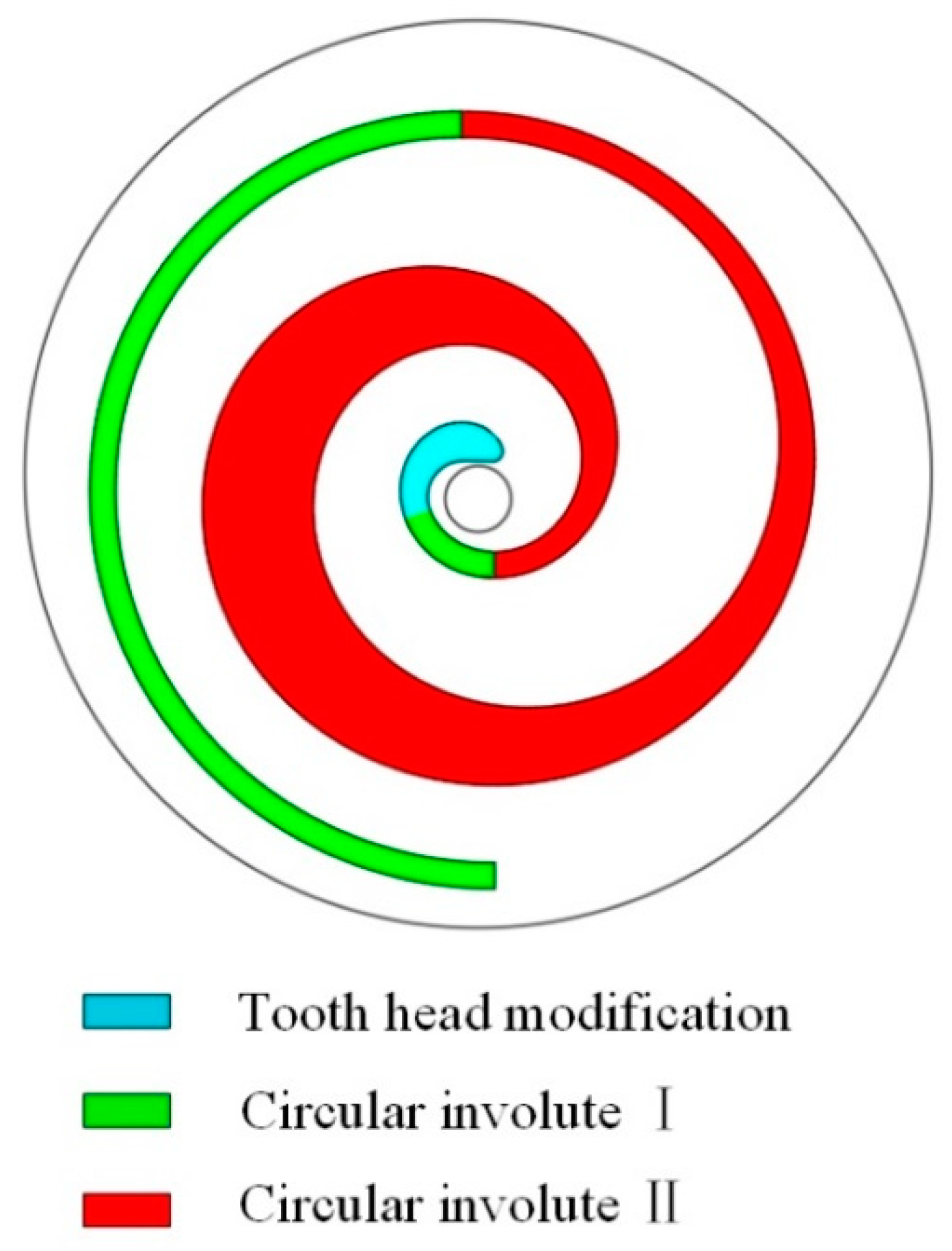
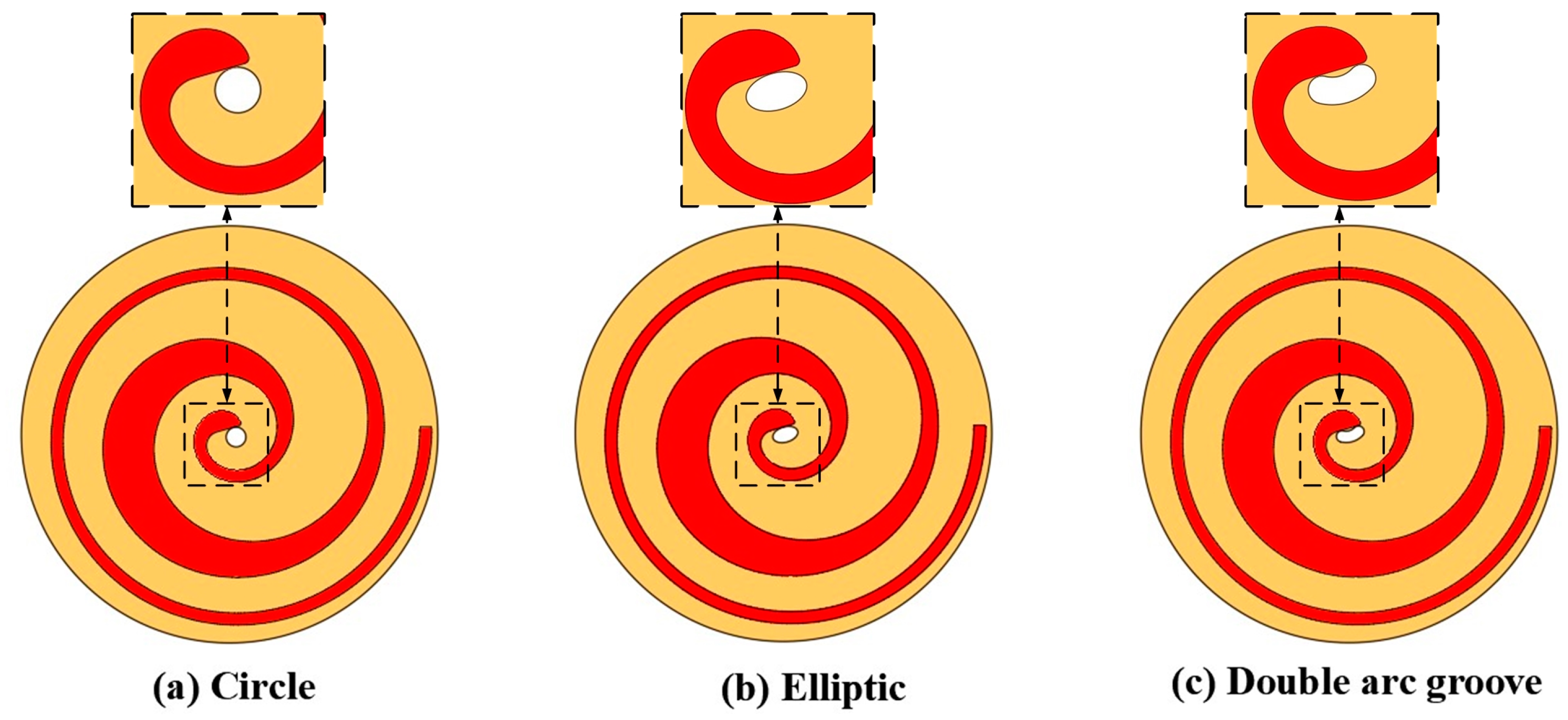

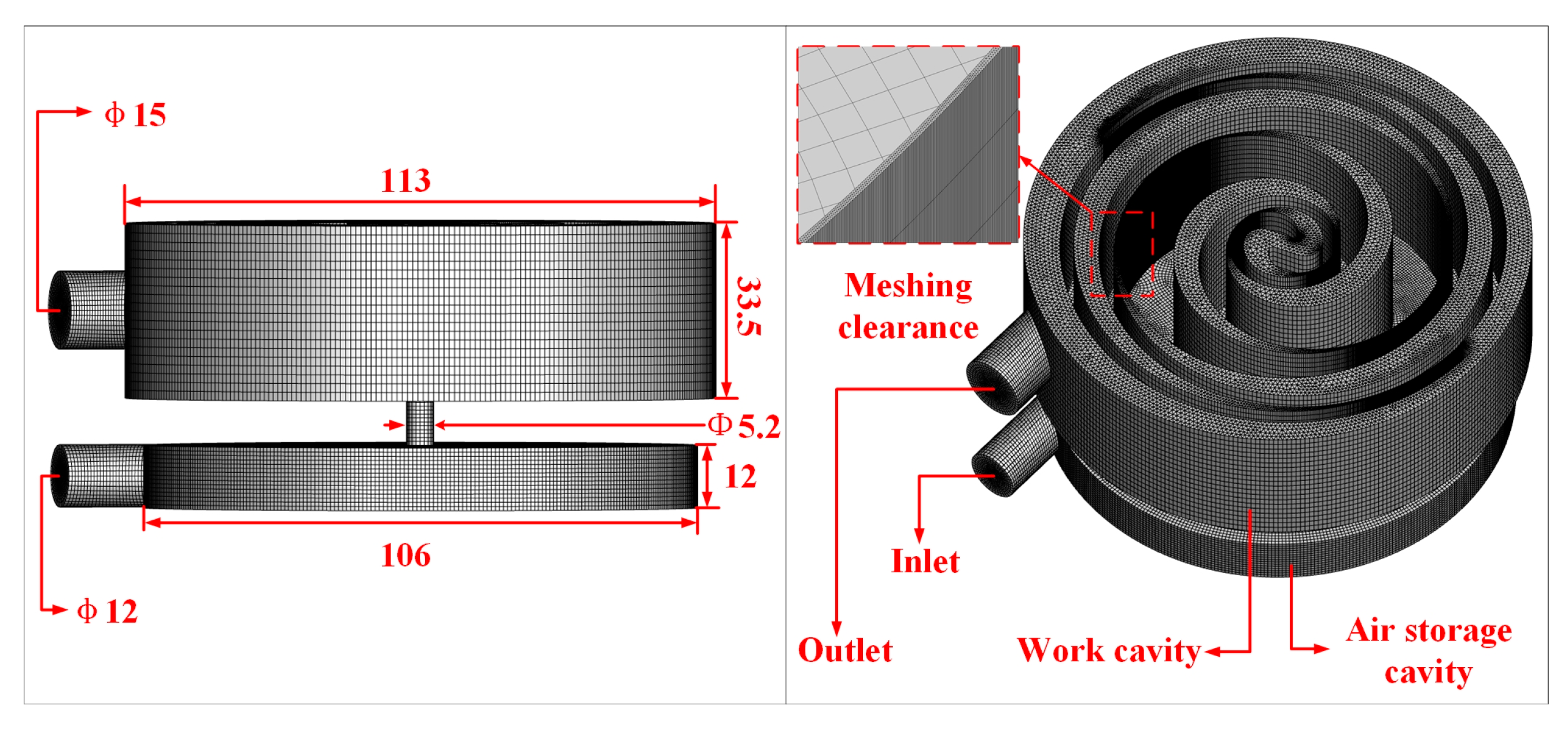
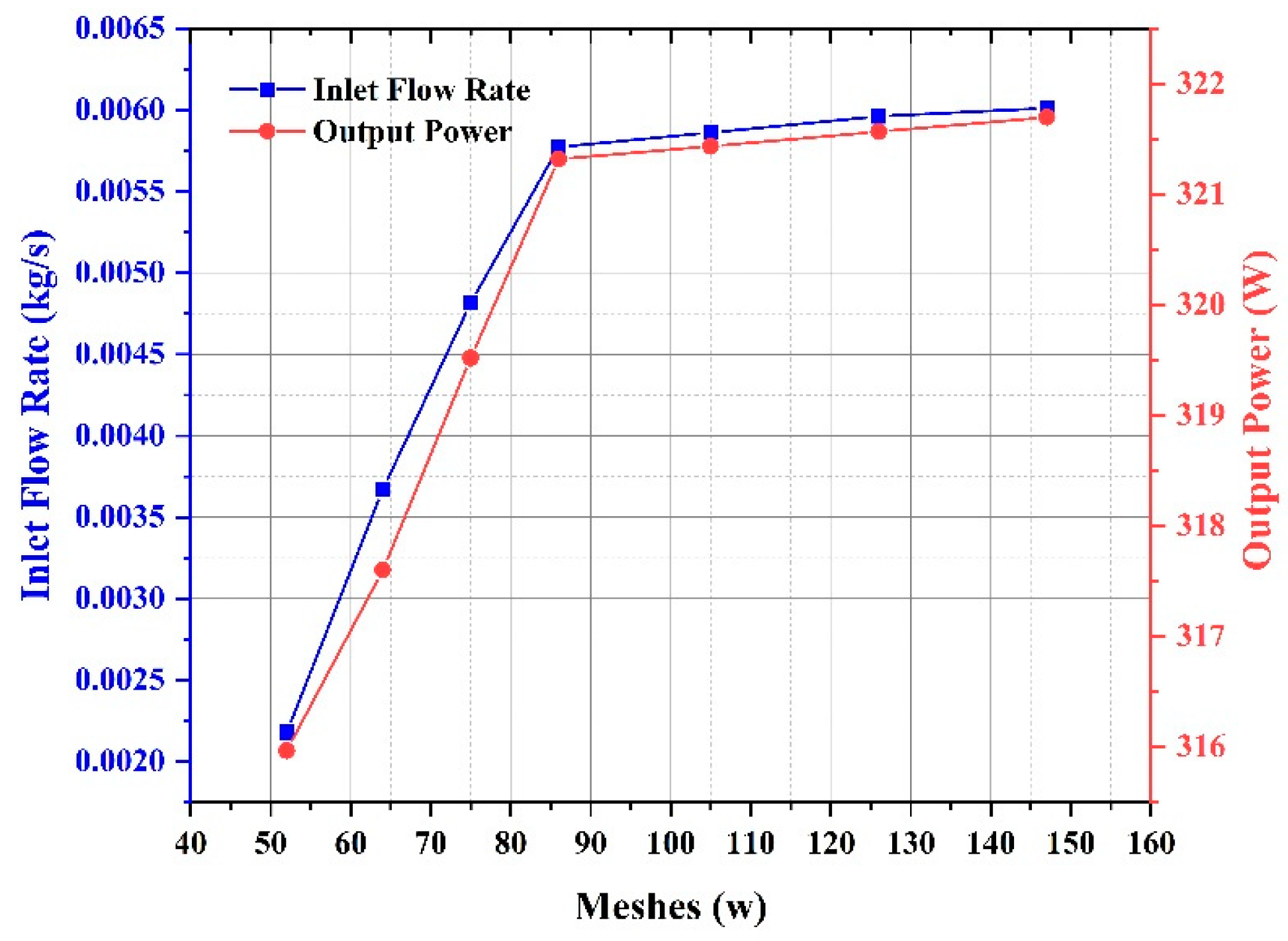
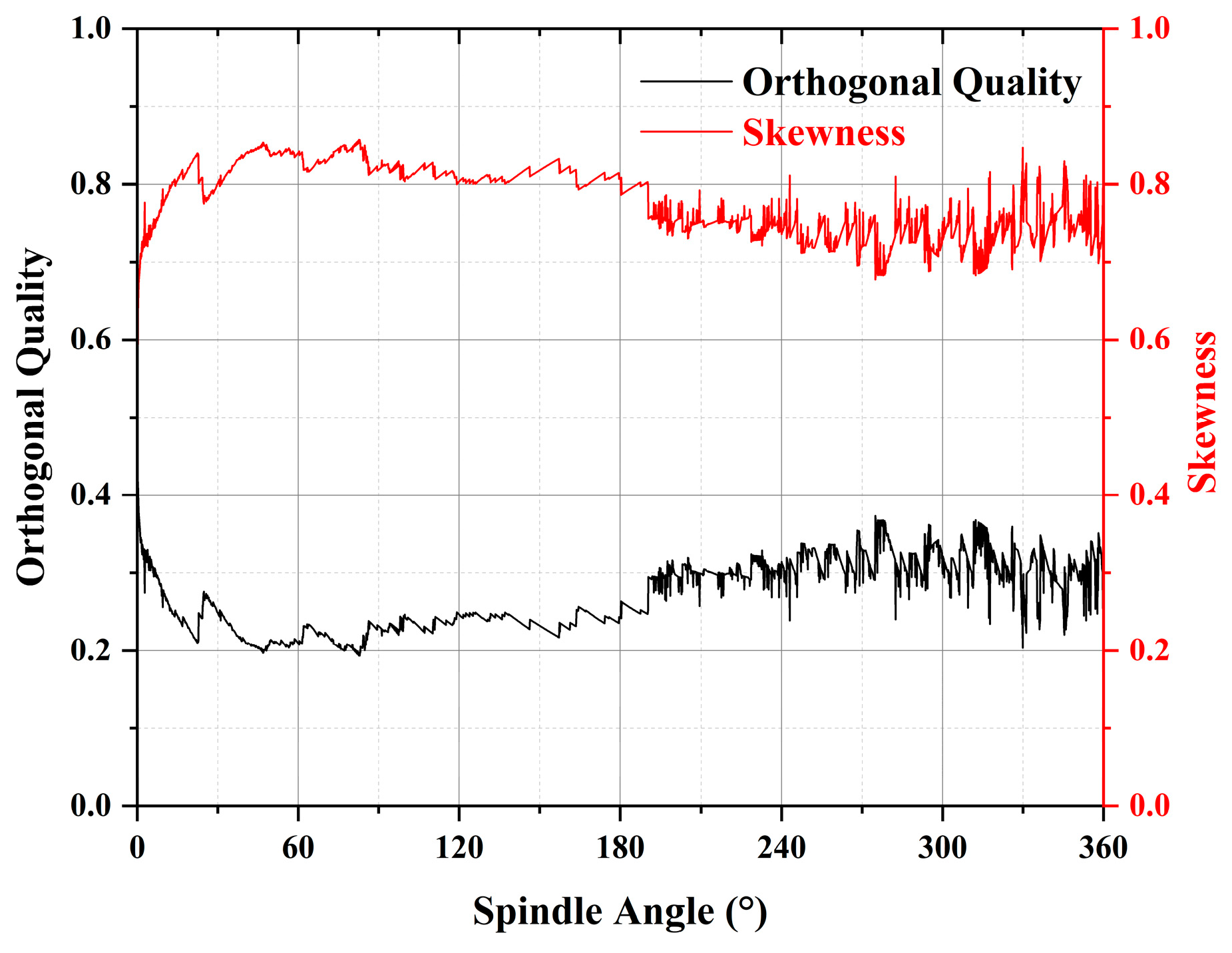

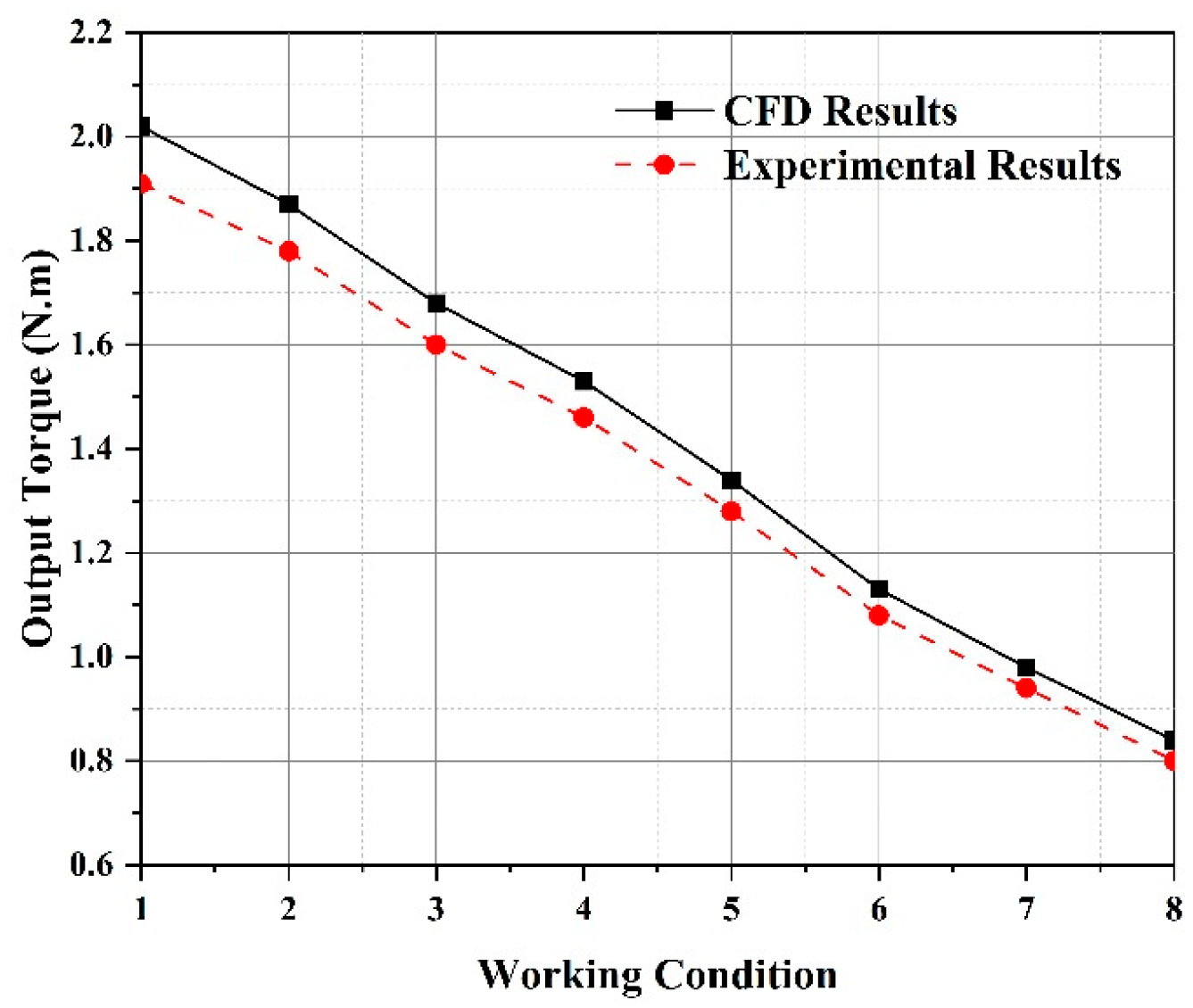
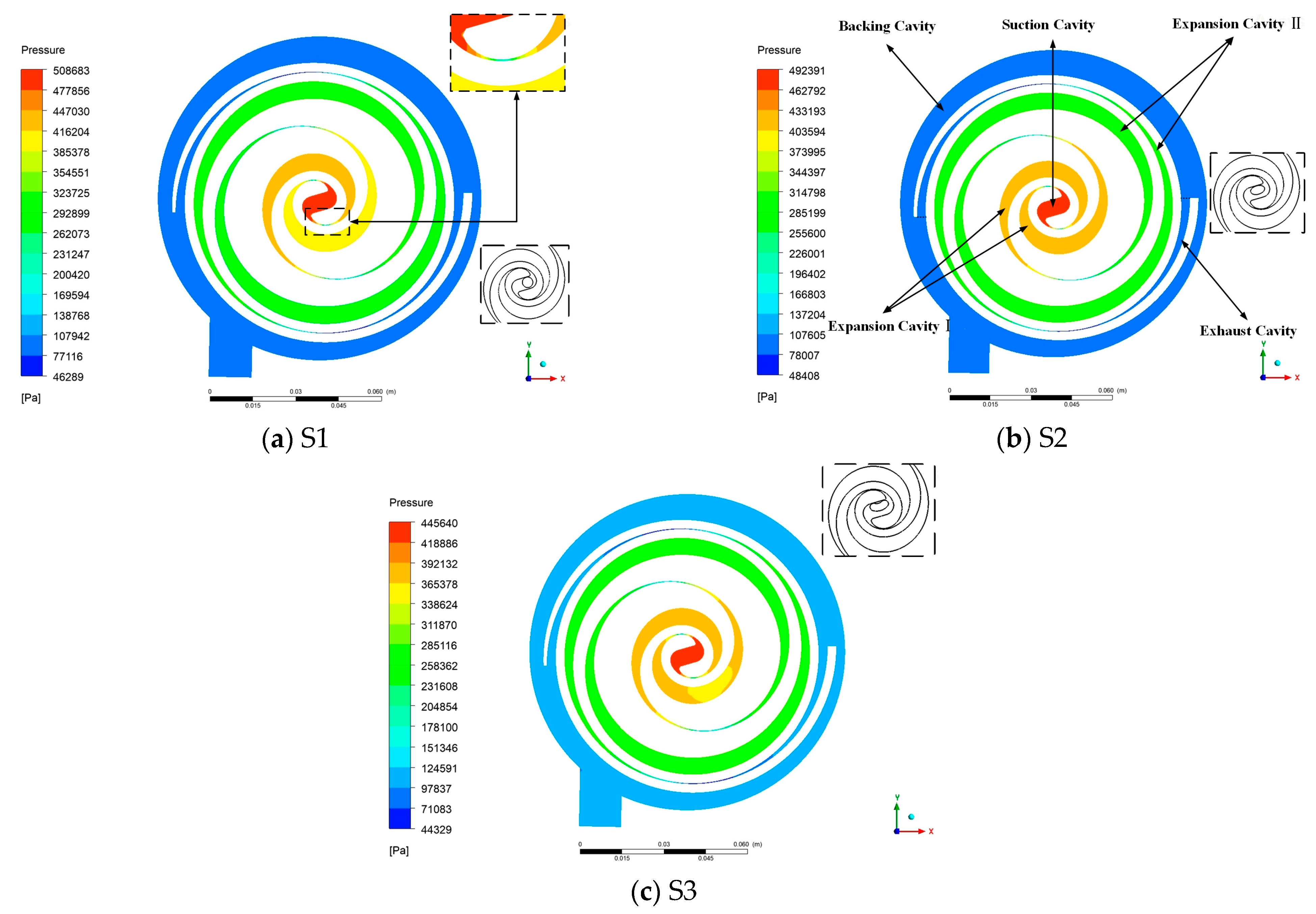

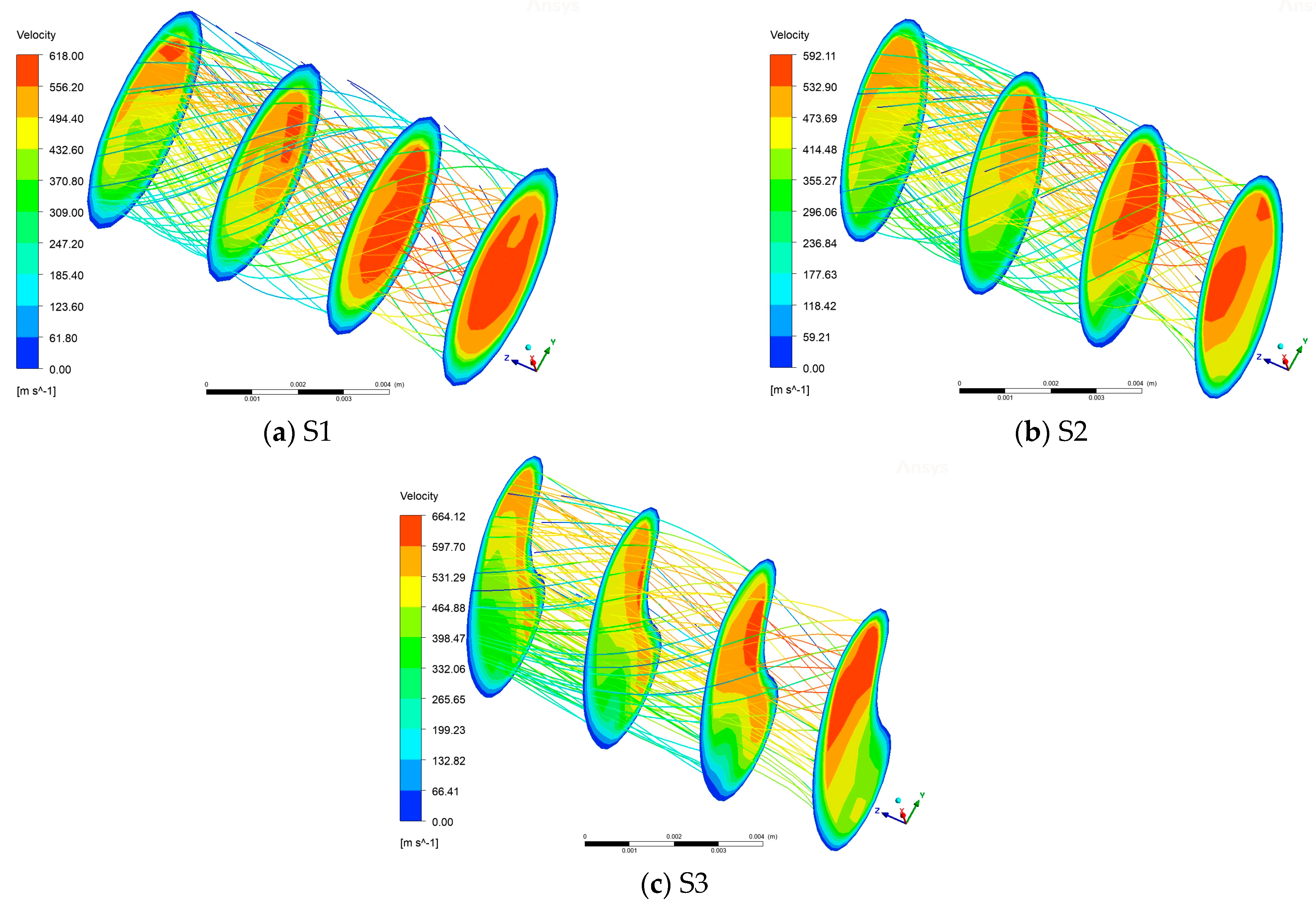
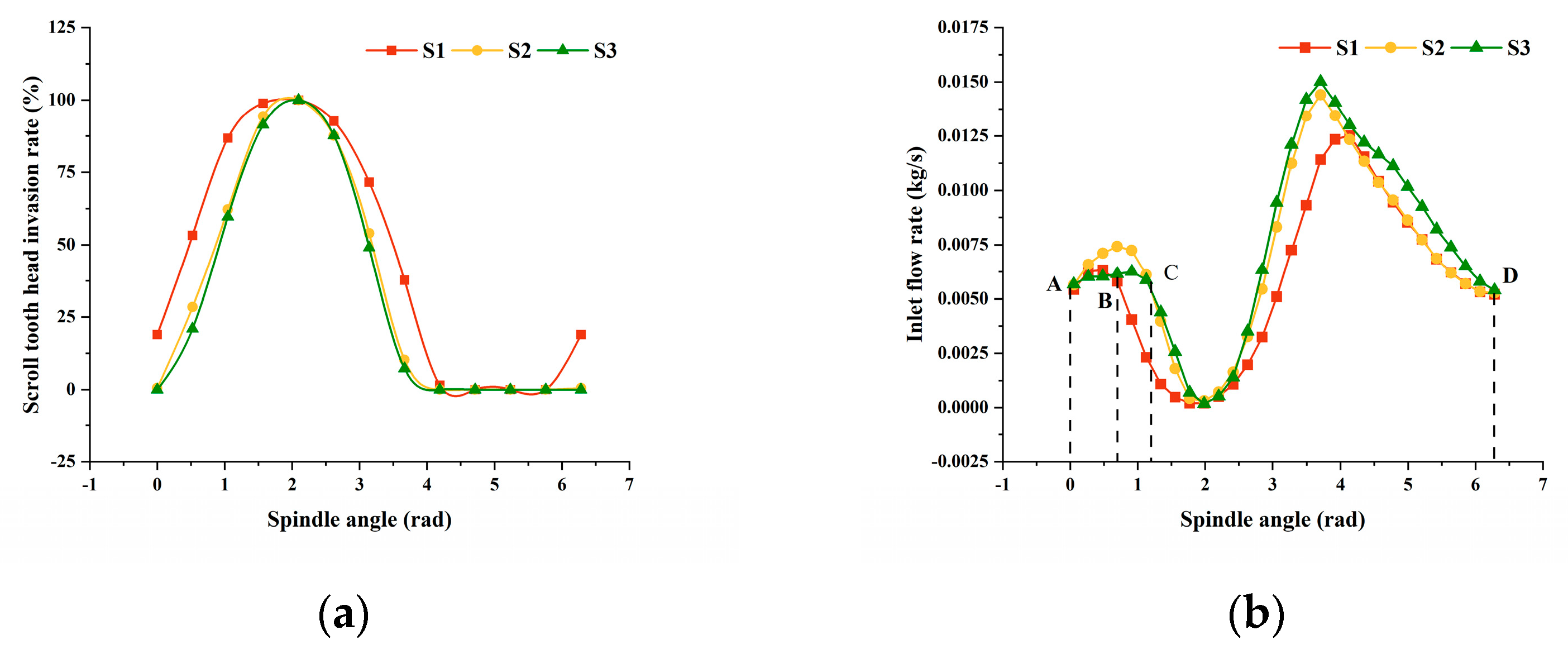
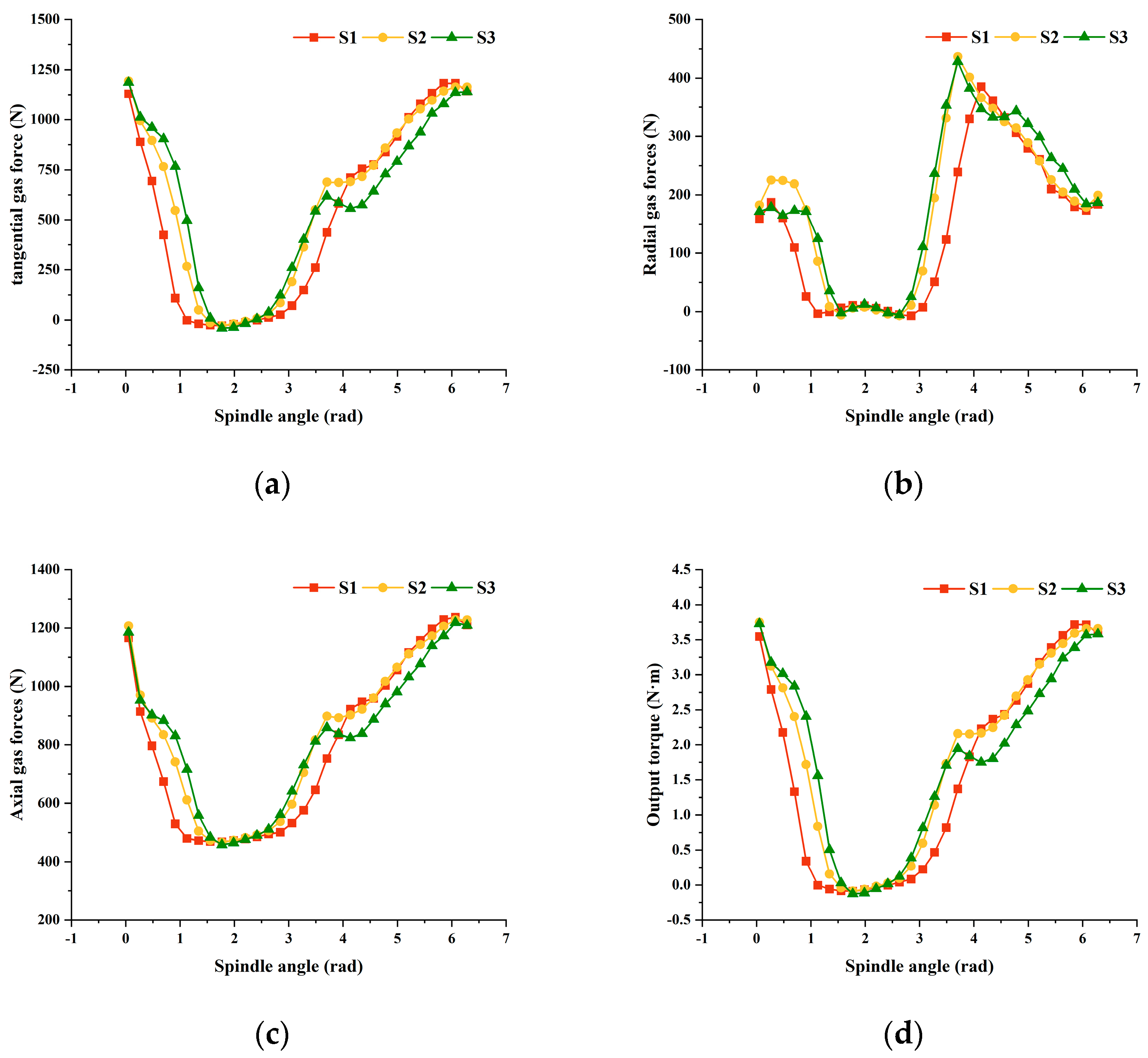
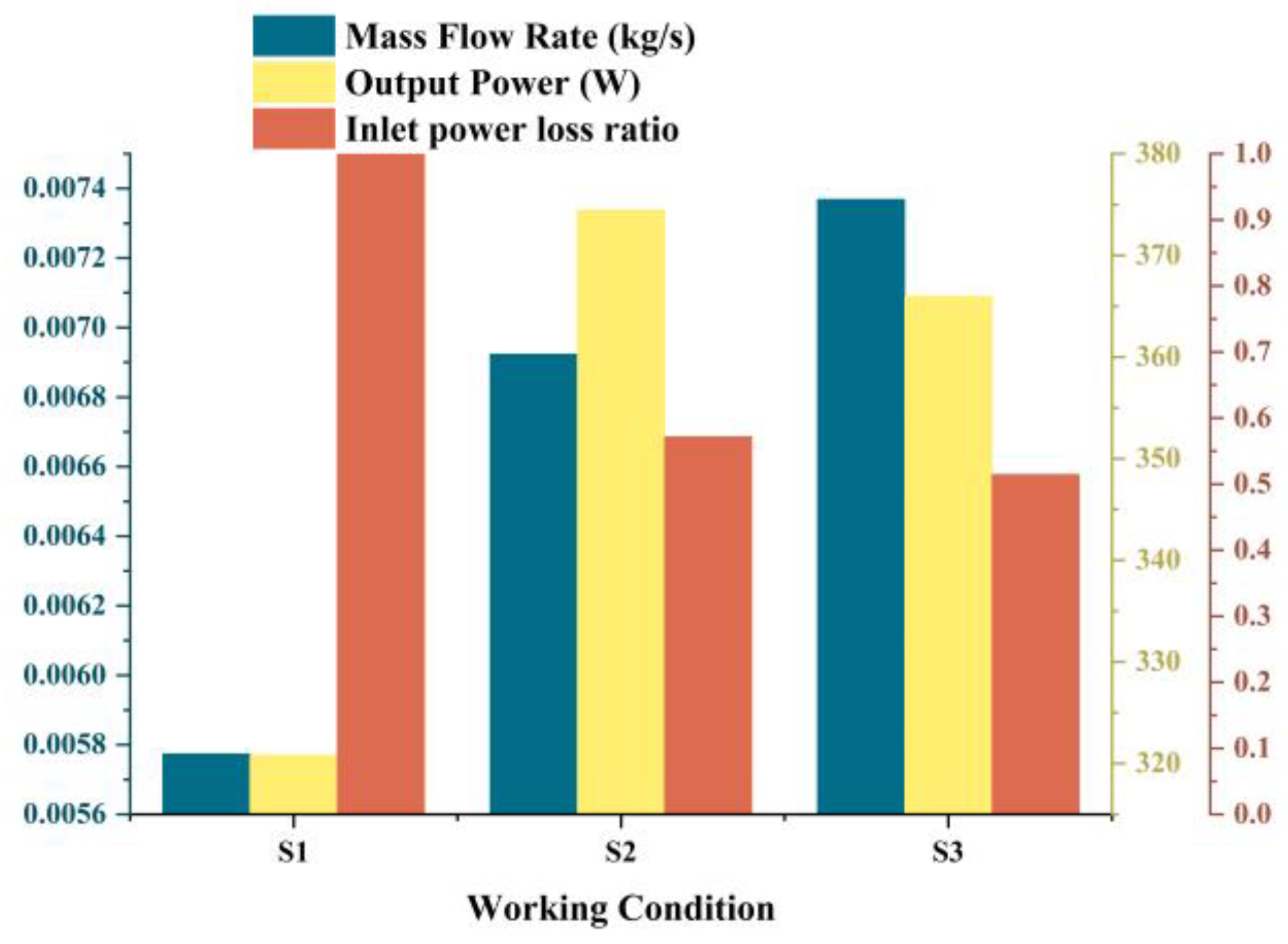
| Parameter Name | Symbolic | Value | Unit |
|---|---|---|---|
| Base circle radius | |||
| Involute incidence angle | |||
| Turning radius | |||
| Involute angle | |||
| Involute end angle | |||
| Median value | |||
| Number of laps | |||
| Spring Setting | Parameters | Methods-Based Remeshing | Parameters |
|---|---|---|---|
| Spring Constant Factor | 0.1 | Minimum Length Scale | 0.1 mm |
| Convergence Tolerance | 0.001 | Maximum Length Scale | 1 mm |
| Maximum Number of Iterations | 20 | Maximum Cell Skewness | 0.8 |
| Elements | Tet in Tet Zones | Maximum Face Skewness | 0.7 |
| Laplace Node Relaxation | 1 | Size Remeshing Interval | 1 |
| Parameter Name | Value | Unit |
|---|---|---|
| Density | Ideal gas | kg/m3 |
| Specific Heat Capacity | 1006.43 | J/kg·K |
| Coefficient of Thermal Conductivity | 0.0242 | W/m·K |
| Viscosity | 1.7894 × 10−5 | kg/(m·s) |
| Relative molecular mass | 28.966 | kg/kmol |
| Types | Fluid Materials | Pressure | Temperature |
|---|---|---|---|
| Pressure-inlet | Air | 0.7 Mpa | 373 K |
| Pressure-outlet | Air | 0.1 Mpa | 300 K |
| Working Condition | Inlet Pressure/Mpa | Inlet Temperature/K | Outlet Pressure/Mpa | Outlet Temperature/K | Rotation Speed/rpm |
|---|---|---|---|---|---|
| 1 | 0.75 | 296.98 | 0.30 | 292.10 | 1203 |
| 2 | 0.70 | 296.80 | 0.28 | 289.84 | 1177 |
| 3 | 0.65 | 296.79 | 0.25 | 289.15 | 1103 |
| 4 | 0.60 | 296.75 | 022 | 288.82 | 1036 |
| 5 | 0.55 | 296.59 | 0.20 | 289.81 | 989 |
| 6 | 0.50 | 296.62 | 0.17 | 289.11 | 872 |
| 7 | 0.45 | 296.58 | 0.15 | 289.56 | 807 |
| 8 | 0.40 | 296.53 | 0.13 | 290.19 | 733 |
Disclaimer/Publisher’s Note: The statements, opinions and data contained in all publications are solely those of the individual author(s) and contributor(s) and not of MDPI and/or the editor(s). MDPI and/or the editor(s) disclaim responsibility for any injury to people or property resulting from any ideas, methods, instructions or products referred to in the content. |
© 2023 by the authors. Licensee MDPI, Basel, Switzerland. This article is an open access article distributed under the terms and conditions of the Creative Commons Attribution (CC BY) license (https://creativecommons.org/licenses/by/4.0/).
Share and Cite
Wei, J.; Li, G.; Yin, G.; Chang, W.; Zhang, C.; Li, X.; Wang, J. Analysis of Flow Characteristics at the Inlet of a Circular Involute Variable Wall Thickness Scroll Expander. Processes 2023, 11, 3117. https://doi.org/10.3390/pr11113117
Wei J, Li G, Yin G, Chang W, Zhang C, Li X, Wang J. Analysis of Flow Characteristics at the Inlet of a Circular Involute Variable Wall Thickness Scroll Expander. Processes. 2023; 11(11):3117. https://doi.org/10.3390/pr11113117
Chicago/Turabian StyleWei, Junying, Gang Li, Guangxian Yin, Wenwen Chang, Chenrui Zhang, Xueyi Li, and Jidai Wang. 2023. "Analysis of Flow Characteristics at the Inlet of a Circular Involute Variable Wall Thickness Scroll Expander" Processes 11, no. 11: 3117. https://doi.org/10.3390/pr11113117
APA StyleWei, J., Li, G., Yin, G., Chang, W., Zhang, C., Li, X., & Wang, J. (2023). Analysis of Flow Characteristics at the Inlet of a Circular Involute Variable Wall Thickness Scroll Expander. Processes, 11(11), 3117. https://doi.org/10.3390/pr11113117





